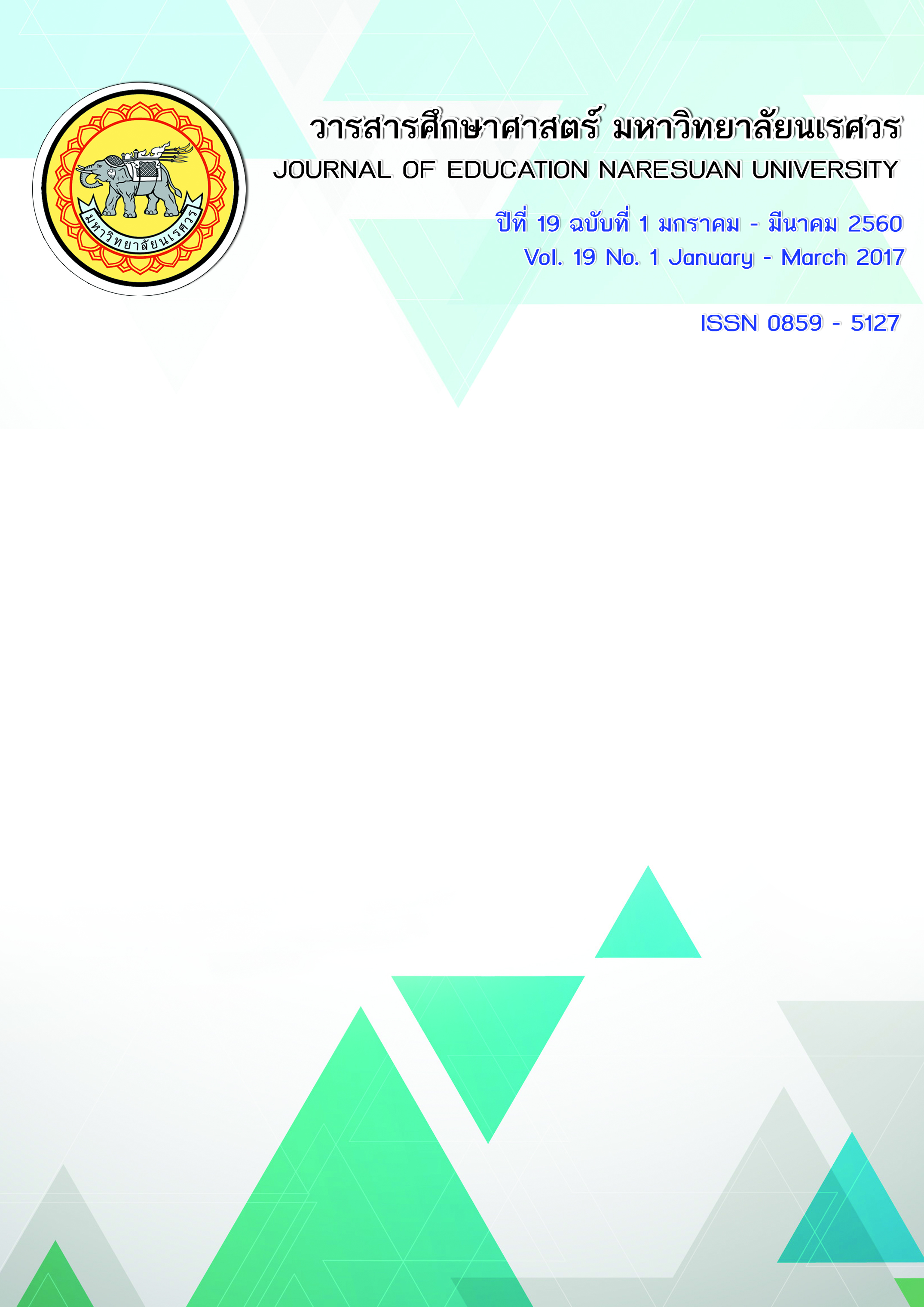การพัฒนาชุดฝึกอบรมเพื่อส่งเสริมความภาคภูมิใจในตนเอง สำหรับนักเรียนชั้นมัธยมศึกษาตอนต้นในโรงเรียนขยายโอกาสทางการศึกษา
Main Article Content
Abstract
การวิจัยครั้งนี้มีจุดมุ่งหมายเพื่อศึกษาความภาคภูมิใจในตนเอง และสร้างชุดฝึกอบรมเพื่อส่งเสริมความภาคภูมิใจในตนเองสำหรับนักเรียนชั้นมัธยมศึกษาตอนต้นในโรงเรียนขยายโอกาสทางการศึกษา กลุ่มตัวอย่างที่ใช้ในการวิจัย คือ นักเรียนชั้นมัธยมศึกษาตอนต้นในโรงเรียนขยายโอกาสทางการศึกษา สังกัดสำนักงานการศึกษาขั้นพื้นฐาน ปีการศึกษา 2556 โดยแบ่งออกเป็น 2 กลุ่ม คือ กลุ่มตัวอย่างในการศึกษาความภาคภูมิใจในตนเอง เป็นนักเรียนชั้นมัธยมศึกษาปีที่ 1-3 ซึ่งได้จากการสุ่มแบบหลายขั้นตอน (Multi-stage random sampling) 1) โดยแบ่งชั้นภาคภูมิศาสตร์ 4 ภาค 4 จังหวัด 4 สำนักงานเขตพื้นที่การศึกษา จับฉลากชื่ออำเภอ โรงเรียน และรายชื่อนักเรียน ตามสัดส่วนที่กำหนดไว้ จำนวน 1,146 คน และกลุ่มตัวอย่างที่ทดลองใช้ชุดฝึกอบรมเพื่อส่งเสริมความภาคภูมิใจในตนเองเป็นนักเรียนชั้นมัธยมศึกษาปีที่ 1-3 โรงเรียนอนุบาลสวรรคโลก(คุ้งวารีวิทยา) จังหวัดสุโขทัย ซึ่งได้ด้วยวิธีคัดเลือกแบบเจาะจง (Purposive sampling) จำนวน 31 คน เครื่องมือที่ใช้ในการวิจัย ได้แก่ 1) ชุดฝึกอบรมเพื่อส่งเสริมความภาคภูมิใจในตนเอง 2) แบบวัดความภาคภูมิใจในตนเอง มีค่าความเชื่อมั่นเท่ากับ 0.97 วิเคราะห์ข้อมูลการวิจัยโดยใช้ค่าเฉลี่ย ส่วนเบี่ยงเบนมาตรฐาน สถิติการทดสอบที และการวิเคราะห์องค์ประกอบเชิงยืนยันด้วยโปรแกรม LISREL 8.30
ผลการวิจัย พบว่า
1. องค์ประกอบความภาคภูมิใจในตนเอง ประกอบด้วย การกล้าแสดงออก การเห็นคุณค่าในตนเอง การยอมรับตนเอง การเคารพตนเอง การได้รับการยอมรับจากบุคคลอื่นในสังคม ความรับผิดชอบต่อตนเอง ความพอใจในตนเอง และความเชื่อมั่นใจตนเอง มีค่าความสอดคล้องเชิงประจักษ์ มีน้ำหนักองค์ประกอบมาตรฐานอยู่ในเกณฑ์สูง อย่างมีนัยสำคัญทางสถิติที่ระดับ .01
2. ชุดฝึกอบรมเพื่อส่งเสริมความภาคภูมิใจในตนเองสำหรับนักเรียนชั้นมัธยมศึกษาตอนต้นในโรงเรียนขยายโอกาสทางการศึกษาประกอบด้วย 4 โมดูล
3. นักเรียนมีความภาคภูมิใจในตนเอง ก่อนกับหลังใช้แตกต่างกันอย่างมีนัยสำคัญทางสถิติที่ระดับ .05 แต่หลังใช้กับระยะติดตามผลแตกต่างกันอย่างไม่มีนัยสำคัญทางสถิติที่ระดับ .05
4. ชุดฝึกอบรมเพื่อส่งเสริมความภาคภูมิใจในตนเองมีผลการประเมินความเหมาะสมอยู่ในระดับดี
THE DEVELOPMENT OF A TRAINING PACKAGE TO PROMOTE SELF-ESTEEM FOR LOWER SECONDARY STUDENTS IN EDUCATIONAL OPPORTUNITY EXPANSION SCHOOLS
The purposes of this study were to study self-esteem and creating a training package to promote self-esteem for lower secondary students in Educational Opportunity Expansion Schools. The students were divided into two groups. The first group was a self-esteem study group. This group consisted of 1,146 students stratified by four geographic regions (four provinces with four Education Service Area Offices). The second group included 31 subjects of Anubansawankalok School (Kungwareewittaya) in Sukhothai Province. This group of 31 subjects participated in a training package. The research tool was a training package to promote self-esteem for lower secondary students in Educational Opportunity Expansion Schools. The results are as follows:
1. The confirmatory factor analysis stated significantly that the model of self-esteem functioning can be characterized by eight factors: self–assertiveness, self–worthiness, self-acceptance, self-respect, social acceptance, self-responsibility, self-satisfaction and self-confidence. These eight factors have high factor loading at .01 level and could be measured by the self-esteem functioning factors. The level of self-esteem in the study group was high.
2. The training package was built as a series of workshops guiding the process of learning science concepts, personality, and humanism to believe in the potential of adhering to a student-centered learning, committed learner-centered, which firmly held the success of the group. The training package consisted of four modules.
3. Statistically significant differences in self-esteem of experimental group existed before and after participation in the training package at .05 significance level. However, there was no significant difference after and durig the follow-up period with the training package.
4. The evaluation of the training package shows that it is appropriate at a high level.
Article Details
The owner of the article does not copy or violate any of its copyright. If any copyright infringement occurs or prosecution, in any case, the Editorial Board is not involved in all the rights to the owner of the article to be performed.


